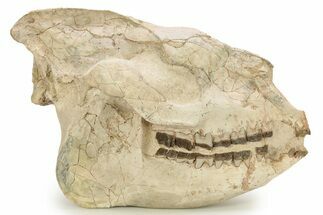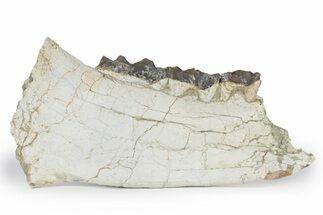This Specimen has been sold.
.27" Fossil Opossum-Like Mammal (Peratherium) Jaw Section - France
This is a .27" wide portion of the lower jaw (mandible) from the Miocene insectivore, Peratherium cuvieri. The bone contains two teeth. Comes with an acrylic display case.
The genus Peratherium consists of opossum-like mammals of the family Herpetotheriidae, that lived mostly from the early Eocene through the early Miocene throughout what is now Europe and Africa. They were metatherian mammals: metatherians were closely related to modern marsupials. One way to tell metatherian mammal fossils apart from non-marsupial mammals, or eutherians, is to count the number of molars on each jaw: metatherians like Peratherium species have four pairs of molars on each jaw, while eutherian mammals only have three.
The Quercy Phosphorites Formation in France is world famous for its Eocene to Miocene faunas, especially those from the upper Eocene to lower Oligocene. The latter particularly helped to understand the ‘Grande Coupure’, a dramatic faunal turnover event that occurred in Europe during the Eocene-Oligocene transition. Fossils from the Quercy Phosphorites were excavated during the mid-19th century until the early 20th century from a series of sites that are no longer accessible. These fossils have subsequently dispersed between several research institutions, unfortunately losing some temporal and geographical information in the process. This material is part of an old collection we acquired that presumably was collected along with this material in the 19th or early 20th century. A recently published paper on the mammals of the Quercy Phosphorites can be found below.
The upper Eocene-Oligocene carnivorous mammals from the Quercy Phosphorites (France) housed in Belgian collections
The upper Eocene-Oligocene carnivorous mammals from the Quercy Phosphorites (France) housed in Belgian collections
SPECIES
Peratherium cuvieri
LOCATION
Lot (Formerly Quercy), France
FORMATION
Quercy Phosphorites Formation
SIZE
.27" Wide
CATEGORY
ITEM
#248712
We guarantee the authenticity of all of our specimens.
 Reviews
Reviews











